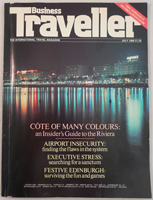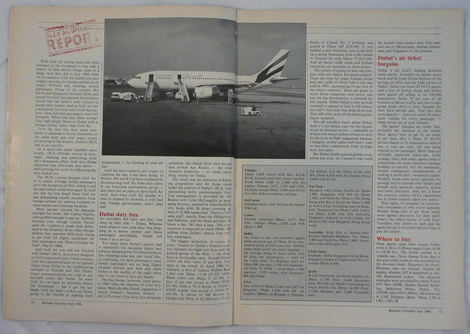Alex McWhirter looks through the Business Traveller archive. This month: an interview with a fledgling Emirates in July 1986.
 Dubai felt insecure in the mid-1980s. The Gulf city-state depends on trade for a living. It therefore relies entirely on air travel for connectivity. Yet developments at that time risked the emirate becoming isolated.
Dubai felt insecure in the mid-1980s. The Gulf city-state depends on trade for a living. It therefore relies entirely on air travel for connectivity. Yet developments at that time risked the emirate becoming isolated.
The policy of Gulf Air – the then national airline of Bahrain, the UAE, Oman and Qatar – was to favour Bahrain over Dubai as a Gulf springboard to the outside world. Worse still, the advent of the long-distance B747-400 aircraft would soon enable the large carriers to axe their Gulf refuelling stops when flying from Europe to Asia. It meant Dubai would soon lose its daily nonstop links to important business centres such as London, Hong Kong and Singapore.
In those days, Dubai was a minor destination. Had it not been for the fact that it was ideally placed as a refuelling point, the many long-distance services operated by British Caledonian (now part of British Airways), Cathay Pacific, KLM, Malaysia Airlines, Singapore Airlines and others would not have called in. This provided Dubai travellers with global links, but once these foreign carriers acquired B747-400s, they either downgraded or, worse still, axed Dubai from their networks.
So Emirates’ raison d’être was one of connectivity. It was set up to place Dubai on the world map. And it’s a feat it has achieved many times over thanks to government will, lots of money and Dubai’s pro-aviation policy.
When I interviewed Emirates managing director Maurice Flanagan in spring 1986, the fledgling carrier had a fleet of three planes. Two were leased from PIA (Pakistan International) while the third was owned by the city-state’s Ruler himself. The airline served only a handful of regional destinations.
Today’s fleet consists of about 200 planes and the Emirates network now covers around 120 destinations on six continents. The airline is now the world’s largest in terms of flown international mileage, and Dubai has been transformed into one of the world’s largest international hubs.
But Emirates has found that with success comes protectionism. Some countries are jealous of its success and do their utmost to restrict its expansion, so it must act smart to expand. Today’s Dubai hub feeds passengers as easily between Europe, Asia and Australasia as it does between Africa, India and China.
In doing so, Emirates has done a great service to the consumer. Main and secondary business cities, long neglected by their home airlines, can now boast efficient links to the outside world thanks to Emirates and Dubai.









